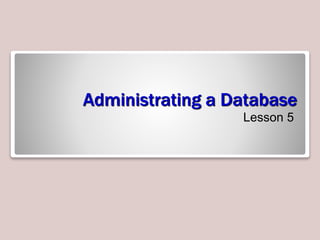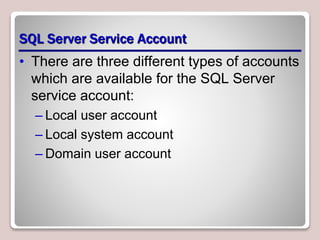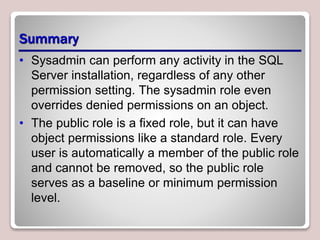Ad
98_364_Slides_Lesson05.ppt
- 2. Objectives
- 3. Database Security • Security, like every other aspect of the database project, must be carefully designed, implemented, and tested. • Because security may affect the execution of some procedures, it must be taken into account when the project code is being developed. • A permission is used to grant an entity (such as a user access) to an object (such as another user or a database). • In SQL Server, the security model is based on what is referred to as “securables”.
- 4. Logins and Accounts • A login or logon is the process by which an individual’s access to a computer system is controlled by identification of that user using credentials provided by that user. • The most common login method is using a username and password. • A user account is a logical representation of a person within a electronic system.
- 5. Server-Level Security • The three different methods for which a user can be initially identified include: – Windows user login – Membership in a Windows user group – SQL Server-specific login (if the server uses mixed-mode security) • It is important to remember that at the SQL Server level, where the database resides, users are known by their login name. This can be a SQL Server login, Windows domain, or a username login choice.
- 6. Database-Level Security • Even though a user may belong to a fixed database role and have certain administrative level permissions, a user still cannot access the data without first being granted permission to the database object itself (e.g., tables, stored procedures, views, functions). • All users are automatically members of the public standard database role.
- 7. Object Permissions • Each object’s permission is assigned through either granting, revoking, or denying user login permissions. – Grant permission means the user can access the object. – Deny permission overrides a grant permission. – Revoke permission removes the permission assigned, regardless of whether it’s deny or grant.
- 8. SQL Server Service Account • There are three different types of accounts which are available for the SQL Server service account: – Local user account – Local system account – Domain user account
- 9. Authentication • Authentication is the act of establishing or confirming a user or system identity. • Windows Authentication mode is superior to mixed mode because users don’t need to learn yet another password and because it leverages the security design of the network.
- 10. SQL Accounts • SQL servers also support mixed mode, which allows you to connect to the SQL server using Windows authentication or SQL Server authentication. • A SQL Server login account and related passwords are defined on the SQL server and are not related to Active Directory or Windows accounts. • Associated with SQL authentication is the sa account, the built-in SQL administrator account associated with SQL authentication.
- 11. Database Server Roles • SQL Server includes fixed, predefined server roles: – Bulkadmin – Dbcreator – Diskadmin – Processadmin – Securityadmin – Serveradmin – Setupadmin – Sysadmin
- 12. Guest Logon Accounts • Any user who wishes to access a database but has not been declared a user within the database will automatically be granted the user privileges of the guest user, as long as the guest user account has been created. • The guest user account is not actually created when a database is created. It must be specifically added in through the SQL Server Management Studio interface or through a Transact-SQL statement.
- 13. Fixed Database Roles • SQL Server includes a few standard, or fixed, database roles – db_accessadmin – db_backupoperator – db_datareader – db_datawriter – db_ddladmin – db_denydatareader – db_denydatawriter – db_owner – db_securityadmin
- 14. Object Permissions • Object permissions are the permissions that allow a user to act on the database objects (such as tables, stored procedures, and views): – Select – Insert – Update – Delete – DRI (References) – Execute
- 15. Ownership Chains • In SQL Server databases, users often access data by going through one or several objects. • Ownership chains apply to views, stored procedures, and user-defined functions. • If the ownership chain is broken (meaning there’s a different owner between an object and the next lower object), SQL Server checks the user’s permission for every object accessed.
- 16. Backups • The purpose of a database backup is so that you have something to restore if data is lost during a business’s daily routine. • A user may accidentally delete a table or a database administrator may need to restore multiple tables on different servers in order to combine them into one database. • The need for a database backup and restore plan for a business are immediate and far reaching.
- 17. Types of Backups • Full backup: A full backup contains all the data in a specific database or set of filegroups or files, and also enough log to allow for recovering that data. • Differential backup: . A differential backup contains only the data that has changed since the differential base. • Incremental backup: An incremental backup is based on the last backup of the data. An incremental backup contains only the data that has changed since the last full or incremental backup.
- 18. Partial Backups • Partial and differential partial backups are designed to provide more flexibility for backing up databases that contain some read-only filegroups under the simple recovery model.
- 19. File Backups • The files in a database can be backed up and restored individually. • Using file backups can increase the speed of recovery by letting you restore only damaged files without requiring you to restore the rest of the database.
- 20. Backup Devices • SQL Server backups are created on backup devices, such as disk files or tape media. • You can append new backups to any existing backups on a device or overwrite any existing backups.
- 21. Database Restores • Restore scenarios include the following: – Complete database restore – File restore – Page restore – Piecemeal restore – Recovery only – Transaction log restore – Create a mirror database – Create and maintain a standby server
- 22. Summary • The end result of working with database security is to ensure the rights and responsibilities given to users, through creating users and roles, is enforced through a security plan. • A permission is used to grant an entity (such as a user) access to an object (such as another user or a database). • A login or logon is the process by which individual access to a computer system is controlled by identification of the user using credentials provided by the user. The most common login method is using a username and password.
- 23. Summary • A user account is a logical representation of a person within a electronic system. • Even though a user may belong to a fixed database role and have certain administrative-level permissions, a user still cannot access the data without first being granted permission to the database object itself (e.g., tables, stored procedures, views, functions). • Each object’s permission is assigned through either granting, revoking, or denying user login permissions. • Authentication is the act of establishing or confirming a user or system identity.
- 24. Summary • Windows Authentication mode is superior to mixed mode because users don’t need to learn yet another password and because it leverages the security design of the network. • Associated with SQL authentication is the sa account, which is the built-in SQL administrator account associated with SQL authentication. • SQL Server includes fixed, predefined server roles. Primarily, these roles grant permission to perform certain server-related administrative tasks.
- 25. Summary • Sysadmin can perform any activity in the SQL Server installation, regardless of any other permission setting. The sysadmin role even overrides denied permissions on an object. • The public role is a fixed role, but it can have object permissions like a standard role. Every user is automatically a member of the public role and cannot be removed, so the public role serves as a baseline or minimum permission level.
- 26. Summary • Users must be explicitly granted access to any user database. • The db_owner is a special role that has all permissions in the database. • An application role is a database-specific role intended to allow an application to gain access regardless of the user. • The purpose of a database backup is so that you have something to restore if data is lost during a business’s daily routine.
- 27. Summary • A user may accidentally delete a table or a database administrator may need to restore multiple tables on different servers in order to combine them into one database. • Full backups contain all the data in a specific database or set of filegroups or files and also enough log data to allow for recovering that data. • Differential backups only backs-up data since the last full backup. • Incremental backups only backs-up up data since the last full or incremental backup.
Editor's Notes
- #11: Since it is less secure than Windows logins, it is recommended to avoid mixed mode. However, it is available for backward compatibility.










































































